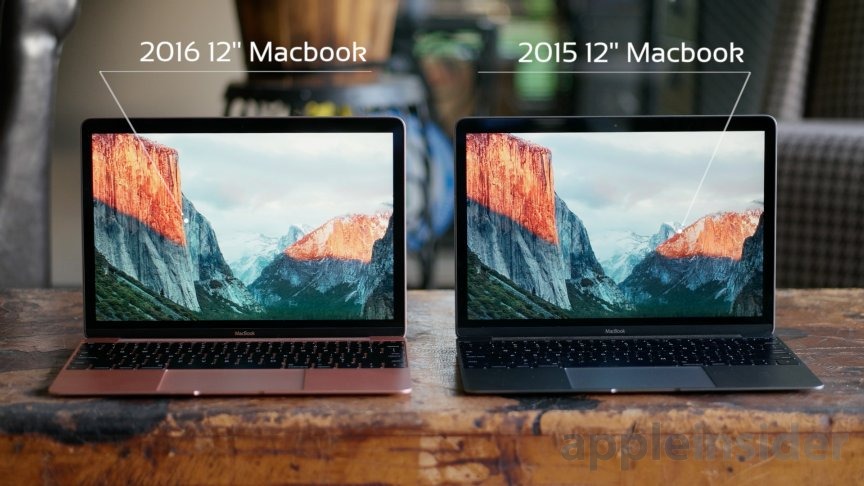Apple was able to squeeze out an extra hour of battery life and modest performance gains from its second-generation 12-inch MacBook, but is that enough to warrant an upgrade from the 2015 model? Find out in AppleInsider's head-to-head video.
With the recent update of the 12-inch MacBook, Apple touted not only battery life increases but also improved performance. Packing a new Skylake processor and integrated graphics, along with faster storage and memory, we wanted to check for ourselves how much of a performance boost the 2016 MacBook provides over last year's model.
We started off comparing the SSD speed which was faster and more consistent in the new MacBook. This should result in a faster loading applications and bootup of the Mac, but in real world usage, we didn't notice much of a difference.
Next, we used GeekBench 3 to test processor performance. Both finished the test at about the same time with the latest MacBook being just slightly faster. Our next test is a CPU and GPU rendering test called Cinebench. Once again the 2016 Macbook pulled ahead by just a bit. (show on screen 4 percent CPU and 10 percent GPU). Moving onto the web browsing benchmark Octane, the new MacBook gets a marginal improvement.
For photographers, we put these MacBooks head to head exporting edited photos with latest version of lightroom. The latest MacBook was about 14 percent faster, which is really negligible unless for some reason your editing thousands of photos on this machine, of the much better suited MacBook Pro.
Taking it one step further we ran the Final Cut benchmark BruceX, which pushed the machines to their limits in video editing. This is the one area we saw a major improvement in, with an almost 300 percent improvement with the 2016 Skylake Macbook. Even so, unless you really need the ultraportable design, video editors will have a smoother experience on a MacBook Pro, which starts at the same price of $1,299.
If you wanted to buy a 12-inch MacBook but were waiting for some big performance improvements, you'll likely need to wait a few more years, or just settle for one of Apples slightly larger offerings that pack a more powerful punch.
 AppleInsider Staff
AppleInsider Staff







-m.jpg)






 Charles Martin
Charles Martin
 Christine McKee
Christine McKee
 Wesley Hilliard
Wesley Hilliard
 Malcolm Owen
Malcolm Owen
 Andrew Orr
Andrew Orr
 William Gallagher
William Gallagher
 Sponsored Content
Sponsored Content







47 Comments
I wouldn't in a million years edit a FCP project on a 12" display. I even find a 13" display small for watching films on. That's more of why I think Apple should move to 14" and 16" models now that's it's obvious the 12" models are here to stay.
rMBA 14" (thinner with with new ports and narrow bezel)
rMBP 16" (where the Pro name really belongs in the Mac notebook lineup; thinner plus narrow bezel etc.)
A simpler layout for the Mac notebook lineup that consumers would actually remember and understand.
And over the next couple of years kill off the non-Retina notebooks, move the prices down and faze out the use of Retina everywhere but the tech specs and keynote bullet point presentations.
MacBook = 12"
MacBook Air = 14"
MacBook Pro = 16"
All Retina, each one slighter thicker, more powerful and with more ports than the last. All 16" model should include dedicated graphics along with integrated graphics. And MacBook should start at $999 at current RAM and HD sizes.
It sounds like unless you really want Rose Gold the 2015 is the better buy.
More so if you can find a discounted price because it's last years model.
The question is whether this is a realistic test. Cinebench and Geekbench are not necessarily the best examples of "real world" usage. How about encoding a video in VLC, editing a photo in Photos, or running Windows 10 in Parallels Desktop or VMWare Fusion? Generally 10% is the threshold of noticeability for "real world" tasks.
Another question is which model did they test? The m3 is actually a "downgrade" relative to the Core M Broadwell chip Apple used last year (Intel culled the Core M line a bit with Skylake and went to 4 available processors from 7). The turbo boost on the m3 is 200MHz slower than last year's base model. On the m5 and m7, it is 100MHz and 200MHz faster, respectively. So if the Skylake m3 is able to outperform the Broadwell 5Y31 chip that Apple used in last year's base, even slightly, that bodes well for more noticeable improvements in the m5 and m7 models.